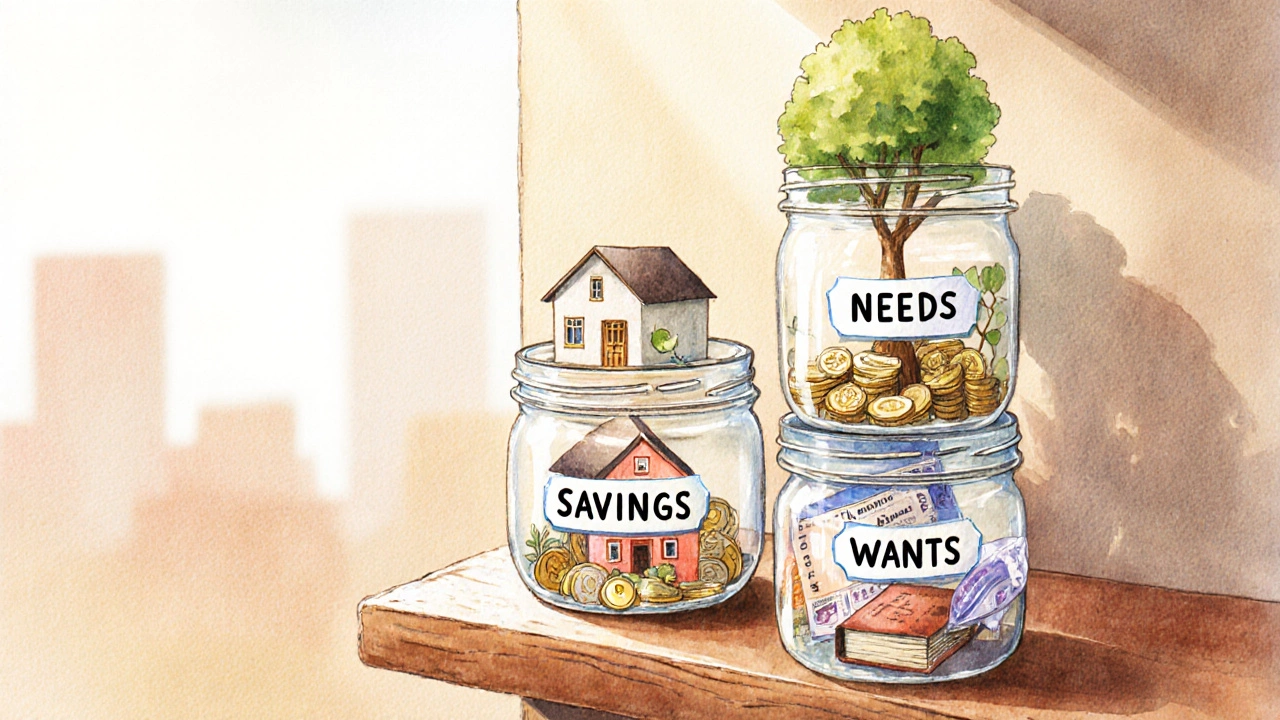50/20/30 Budget Calculator
How the 50/20/30 Budget Rule Works
Divide your after-tax income into three buckets: 50% for needs, 20% for savings/debt, and 30% for wants.
Your Budget
Optional: Enter Your Current Spending
Budget Breakdown
Your Ideal Budget Allocation
Most people feel like their paycheck disappears before the end of the month. You get paid, pay the rent, buy groceries, and suddenly there’s nothing left-not even for that coffee you promised yourself. What if there was a simple system that told you exactly how to split your income so you don’t run out of cash, stay out of debt, and still save for the future? That’s the 50/20/30 budget rule.
What Exactly Is the 50/20/30 Budget Rule?
The 50/20/30 budget rule is a straightforward way to divide your after-tax income into three buckets:
- 50% for needs-things you must pay to survive
- 20% for savings and debt repayment-building your financial future
- 30% for wants-everything that makes life enjoyable
This method was popularized by U.S. Senator Elizabeth Warren in her book All Your Worth, and it’s been used by millions because it doesn’t require tracking every coffee or bus ticket. It gives you breathing room without guilt.
Here’s how it works in real life. If you take home $4,000 a month after taxes:
- $2,000 goes to needs: rent, utilities, groceries, basic transport, minimum debt payments
- $800 goes to savings and debt: emergency fund, retirement account, extra loan payments
- $1,200 goes to wants: dining out, Netflix, hobbies, clothes, weekend trips
It’s not magic. It’s just structure.
What Counts as a ‘Need’?
Needs are non-negotiable. Without them, you can’t live safely or function in society. But here’s where most people mess up-they call things needs that aren’t.
True needs:
- Housing (rent or mortgage)
- Electricity, water, heating, internet (if you work from home)
- Basic groceries and water
- Essential transport (bus pass, car payment if you need it for work)
- Minimum health insurance and prescription costs
- Childcare if you’re working
Things that feel like needs but aren’t:
- Streaming subscriptions (Netflix, Disney+)
- Brand-name clothes or the latest phone
- Expensive gym memberships (a park or home workout works)
- Takeaway coffee every day
- Upgraded cable packages
If you’re spending more than 50% on needs, you’re not necessarily broke-you’re misclassifying. Look at your spending. Can you move something out of needs and into wants? Maybe switch to a cheaper phone plan. Maybe move to a smaller place. That extra 10% can become savings.
Why 20% for Savings and Debt?
This is the part most people skip. They think, “I’ll save when I have more money.” But the 50/20/30 rule flips that. You pay yourself first-before you spend on anything fun.
The 20% includes:
- Building an emergency fund (aim for 3-6 months of living costs)
- Contributions to KiwiSaver or other retirement accounts
- Extra payments on credit cards, student loans, or car loans
- Saving for a house deposit, vacation, or big purchase
Let’s say you have $10,000 in credit card debt at 18% interest. Paying only the minimum could take 20 years. But if you throw $500 a month at it-part of your 20%-you could be debt-free in under 3 years. That’s the power of this bucket.
And if you’re not in debt? Good. That 20% becomes your wealth-building engine. Even $200 a month into KiwiSaver, with employer contributions and compound growth, could turn into over $200,000 in 30 years.

What Can You Spend the 30% On?
This is your freedom zone. You can spend it on anything that brings you joy-without guilt.
Wants include:
- Dining out and takeaways
- Entertainment (movies, concerts, video games)
- Hobbies (painting, photography, musical instruments)
- Travel and weekend getaways
- Non-essential clothing and accessories
- Subscription services you enjoy
The key? Don’t let wants bleed into needs. That’s where budgets break.
For example, if you spend $600 a month on takeaways, that’s fine-if you’re within your 30%. But if you’re spending $1,000 and your rent is $1,800, you’ve got a problem. Your needs are 45%, savings are 0%, and wants are 55%. That’s not sustainable.
Use the 30% to live well, not to live beyond your means.
What If Your Numbers Don’t Fit?
Real life isn’t neat. In Auckland, rent alone can eat up 60% of your income. If you’re in that situation, the rule doesn’t vanish-it adapts.
Here’s how to adjust:
- Start where you are. If your needs are 60%, focus on reducing them first-find a flatmate, move closer to work, or negotiate rent.
- Even if you can’t hit 20% savings yet, aim for 10%. Anything above 0% is progress.
- Trim wants aggressively until you can stabilize. Cut one subscription. Cook one extra meal a week.
- As your income grows or expenses drop, slowly shift toward the 50/20/30 ideal.
There’s no penalty for not hitting the numbers perfectly. The goal is awareness, not perfection.
How to Start Using the 50/20/30 Rule Today
You don’t need an app, a spreadsheet, or a financial advisor. Just follow these steps:
- Calculate your monthly after-tax income. Use your bank statement, not your payslip.
- Track every expense for one month. Use your bank app or a notebook.
- Sort each expense into needs, savings/debt, or wants.
- Add up each category. See where you stand.
- Adjust next month’s spending to move closer to 50/20/30.
Example: Sarah earns $4,500 after tax. Her spending looks like this:
- Needs: $2,800 (62%)
- Savings/debt: $450 (10%)
- Wants: $1,250 (28%)
She’s over on needs, under on savings. So she:
- Switches her phone plan to a cheaper one ($40 saved)
- Starts cooking lunch 3x a week ($70 saved)
- Reduces her streaming services to one ($15 saved)
Now she’s saving $125 more a month. Her needs drop to 55%, savings rise to 13%. She’s on track.

Why This Rule Works Better Than Other Budgets
Most budgets are too strict. You track every dollar and burn out by week three. The 50/20/30 rule works because it’s flexible, human, and forgiving.
It doesn’t say “you can’t have coffee.” It says, “if you want coffee every day, make sure you’re still saving for your future.”
It doesn’t shame you for spending on fun. It just asks: “Is this fun worth sacrificing your safety net?”
And it’s scalable. Whether you earn $30,000 or $120,000, the percentages stay the same. The numbers change-but the mindset doesn’t.
Common Mistakes to Avoid
- Using gross income instead of take-home pay. Always use what lands in your account.
- Forgetting irregular expenses like car repairs, annual insurance, or medical bills. Add those up yearly, divide by 12, and include them in needs.
- Calling debt repayment “want”. Paying off credit cards? That’s savings. It’s reducing future interest.
- Ignoring inflation. If your rent goes up next year, your percentages shift. Revisit your budget every 6 months.
- Thinking it’s permanent. Life changes. A new job, a baby, a move-your numbers will too. That’s normal.
The rule isn’t a cage. It’s a compass.
Who Should Use This Rule?
Anyone who wants to stop living paycheck to paycheck.
It’s perfect for:
- Young professionals just starting out
- People with student debt
- Families trying to save for a home
- Anyone who feels guilty about spending on themselves
It’s not for people who want to become millionaires overnight. But if you want to stop stressing about money, build real security, and still enjoy life-this is one of the most reliable systems out there.
Is the 50/20/30 rule suitable for low-income earners?
Yes, but you may need to adjust the ratios. If your rent and bills take up 70% of your income, focus on reducing expenses and saving even 5% at first. Small steps still build momentum. Look for government support, community food banks, or subsidized transport to lower your needs percentage over time.
Do I have to follow the 50/20/30 rule exactly?
No. The rule is a guideline, not a law. If you’re paying off high-interest debt, you might temporarily shift to 40/40/20-more toward debt, less toward wants. If you’re debt-free and saving aggressively, you might go 50/30/20. The goal is balance, not rigidity.
What if I have irregular income?
Use your average monthly income over the past 6-12 months. If you’re a freelancer or gig worker, set aside a buffer. When you earn more, put the extra into savings. When you earn less, you’ll have room to breathe without dipping into wants.
Does this rule work with KiwiSaver?
Absolutely. Your KiwiSaver contributions count toward the 20% savings bucket. If your employer contributes 3% and you contribute 4%, that’s 7% right there. Add $100 a month to your emergency fund, and you’re at 17%. You’re well on track.
Can I use this rule if I’m in debt?
Yes-especially if you’re in debt. The 20% savings bucket is where you attack debt. Paying more than the minimum on credit cards or loans is part of saving-because you’re avoiding future interest. This rule gives you a clear plan to get out of debt without feeling deprived.
Money isn’t about restriction. It’s about choice. The 50/20/30 rule doesn’t tell you what to do with your money-it helps you decide what matters most. And that’s the real power of budgeting.

